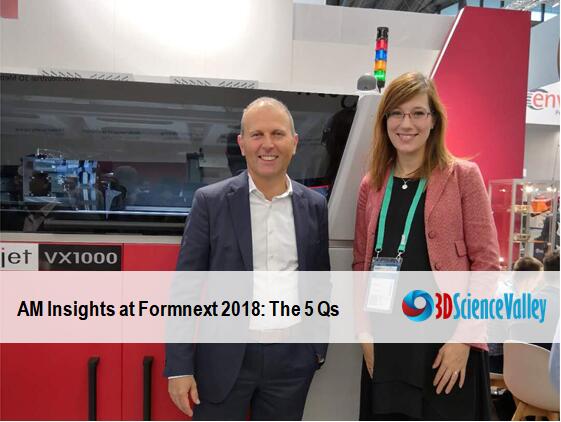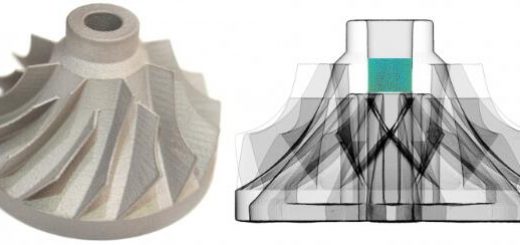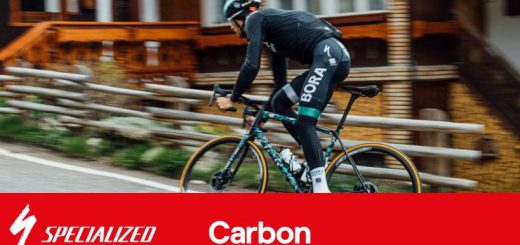AM Insights at formnext: 3D Science Valley interviewed with Dr. Ingo Ederer, CEO of voxeljet

Left: Dr. Ingo Ederer, CEO of voxeljet
Right: Korinna Penndorf, Co-founder of 3D Science Valley
Q1: What are your company’s highlights here at formnext this year?
We are showing two highlights. One is our existing VX1000, but with a dramatic speed enhancement. From typically 60 seconds per layer we are able to achieve improvements down to 12 seconds per layer. This enables us to print a full box in a few hours. We have several full boxes and a box has about 300 litres of built envelope. We are able to process that in a few hours. So you have a fast turnaround and it comes with an inorganic binder material which for casting purposes is a very important material set because it enables the foundry to work on an environmentally friendly system. The sole “pollution” coming out of it is water vapour. Many of the foundries in Europe are forced to switch to other material systems due to stricter (environmental) regulations and this is truly the future in casting especially here in central Europe.
Most of the automotive companies have already switched to this material system. So the machine voxeljet showcase here is already printing in serial production, but to be honest this is only a teaser when compared to the bigger production machine to come next year probably at GIFA, the main foundry show in Germany. We have released before that we received an order by a major automotive form for series production of casting cores out of sand with the same material. This is a pre-production machine, the real production machine comes next year.
Another highlight is our VX200 with high speed sintering. We already displayed this type of machine last year, but this year it comes with several new features, new software. Very important is also the increase in speed. Again from about 35-40 seconds per layer down to below 20 seconds.
Q2: How does this year’s business performance compare to last year’s?
Well, our service business is doing especially well. We have two business lines. One is to build and sell binder jetting printers, but we also have an own operation, where we use those printers for on-demand printing. Especially the on-demand parts printing business is doing extremely well on a global scale. The machinery business is also not so bad but could be better. We believe that the services business and we are also looking at other models such as onsite service for customers. This could be really something for the future.
I think, generally, the (downstream) industry is adopting 3D printing and also our processes more and more and start seeing this as a kind of standard for some applications.
In addition, we have developed several new applications with our technology, for example the concrete casting which can be seen at the Swiss DFAB house in Zürich made this year. A very nice building. Concrete casting, not metal casting, but also made with our moulds. So complete new applications are coming up probably every day. From my standpoint, I have to say it was never before so diverse, so active, so many applications. It’s very interesting and challenging also.
Q3: What’s the major challenge for your business at the moment to tackle?
It’s really the transfer from low volume production to a serial production. So we are on the way to that but we need to recognize that the requirements for serial production are completely different in many aspects. In terms of reproducibility, quality, but also maintenance and service, reliability of the system… This is something new to us. Also the customer needs to adopt that in some way additive manufacturing is different from their traditional manufacturing method. On both sides there’s a way to go. I think we are on the right path with that, but it’s not done yet. This will probably be a task for the next 3 to 5 years to come to a complete solutions for this.
Q4: If you look at the overall industry around you, even though with targeting foundries you are operating in a special segment which doesn’t have as many players as other areas in the AM field, if you look around what are the major developments and obstacles in the market that you see in addition to what you have mentioned before?
You still see a hype with direct metal printing. We believe that direct metal is something important for the prototypes, low volume production and maybe also for some specific niche applications in aerospace. The additive manufacturing industry is definitely profiting from this hype, however not all applications can be addressed with it. Sometimes it’s sad to see that the customers are not willing to look sideways. We have good solutions for metal parts on the indirect way, especially when you are talking about bigger metal parts and bigger quantities. Direct metal is able to fulfil, this requirement. We are here and we can do it, but customers are sometimes not recognising really what is possible with other ways. They think (looking at direct metal) it is not ready yet and if that’s not applicable then we step away from it and go the conventional way. Direct metal definitely driving the industry and we will see improvements there but also on our side as well.
Q5: You mentioned that up to 5 years down the road mass manufacturing with 3D printing will still be a major issue to solve, apart from that what would you expect for the overall market 5 years from now?
In the next 5 years we will see further production runs on the road for different applications. Of course, the aerospace industry as you see they jump completely on board. We will see more and more parts for aerospace printed in different methods. But as well in the automotive industry we will probably see a shift from conventional to more additive and more digital production. The benefits are clear and they need to take the step. In the next 5 years we will see many many plastic parts directly produced also in mass quantities. You will see many interesting developments coming up not only from voxeljet but other players are integrated features, functionality. Means, electric circuits and controls already printed in the part, less assembly, more colours, different materials – materials that can’t be used conventionally … I think the next 5 years will be very interesting.
(end of 5Q)
Additional questions elaborating on the on-demand and on-site services mentioned.
Q: With 3D printing we are thinking digital, distributed manufacturing. With your on-site on-demand services, I would like to ask you to elaborate a bit further: do you offer that globally?
The service we provide is a local business. There’s a radius of about 2000km where we can deliver pieces economically. That’s why we have such locations all around the globe, where we re close to the customers and are able to fulfil, their needs. The service centre structures are in the US, in Germany, in the UK and one very large one in China. We believe this is something we will grow and expand on the current locations but maybe in the future also in other locations.
Another interesting model is on-site production. This is a win-win situation for the customer and the producer of the machine, because you split the risk, have access to the technology without a heavy investment and on the other side the company as us have a steady flow of income. This is something, if the market is reacting in a positive way, we are willing to expand this model.
Q: so this is like a resident engineer that comes with a whole AM production system?
Yes, we bring a facility into the facility of a customer with our own people needed to run it. It is relatively easy for the billing. We invoice on a monthly basis. It is like a flat rate on your phone and that’s well accepted.
Q: Are you already doing this model?
We have two occasions where we are testing this with a good result. Of course, this is not a solution for everyone, but if the quantities are right and the customer is willing to do it, it could be interesting for both sides.




Recent Comments